|
Doss Glacier
Doss Glacier () is a small glacier just east of Mount Boman, flowing into Nimrod Glacier from the northern slopes of the Queen Elizabeth Range. It was mapped by the United States Geological Survey from tellurometer surveys and Navy air photos, 1960–62, and named by the Advisory Committee on Antarctic Names for Edgar L. Doss, a United States Antarctic Research Program glaciologist at Roosevelt Island Roosevelt Island is an island in New York City's East River, within the borough of Manhattan. It lies between Manhattan Island to the west, and the borough of Queens, on Long Island, to the east. Running from the equivalent of East 46th to 85 ..., 1962–63. References Glaciers of the Ross Dependency Shackleton Coast {{ShackletonCoast-geo-stub ... [...More Info...] [...Related Items...] OR: [Wikipedia] [Google] [Baidu] |
Glacier
A glacier (; ) is a persistent body of dense ice that is constantly moving under its own weight. A glacier forms where the accumulation of snow exceeds its Ablation#Glaciology, ablation over many years, often Century, centuries. It acquires distinguishing features, such as Crevasse, crevasses and Serac, seracs, as it slowly flows and deforms under stresses induced by its weight. As it moves, it abrades rock and debris from its substrate to create landforms such as cirques, moraines, or fjords. Although a glacier may flow into a body of water, it forms only on land and is distinct from the much thinner sea ice and lake ice that form on the surface of bodies of water. On Earth, 99% of glacial ice is contained within vast ice sheets (also known as "continental glaciers") in the polar regions, but glaciers may be found in mountain ranges on every continent other than the Australian mainland, including Oceania's high-latitude oceanic island countries such as New Zealand. Between lati ... [...More Info...] [...Related Items...] OR: [Wikipedia] [Google] [Baidu] |
Mount Boman
Sherwin Peak () is a peak, high, surmounting the east side of Otago Glacier southeast of Mount Chivers, in the north part of the Queen Elizabeth Range, Antarctica. Exploration and name Sherwin Peak was mapped by the United States Geological Survey (USGS) from tellurometer surveys and Navy air photos, 1960–62. It was named by the United States Advisory Committee on Antarctic Names (US-ACAN) for James S. Sherwin, ionospheric scientist at Little America V, 1958. Location Sherwin Peak is in the northeast of the Queen Elizabeth Range. It rises above Otago Glacier, which flows northwest along its southwest side to Nimrod Glacier. Nottarp Glacier and Heidemann Glacier are to the east and Tranter Glacier The Nimrod Glacier is a major glacier about 135 km (85 mi) long, flowing from the polar plateau in a northerly direction through the Transantarctic Mountains between the Geologists and Miller Ranges, then northeasterly between the Chur ... forms to the north of ... [...More Info...] [...Related Items...] OR: [Wikipedia] [Google] [Baidu] |
Nimrod Glacier
The Nimrod Glacier is a major glacier about 135 km (85 mi) long, flowing from the polar plateau in a northerly direction through the Transantarctic Mountains between the Geologists and Miller Ranges, then northeasterly between the Churchill Mountains and Queen Elizabeth Range, and finally spilling into Shackleton Inlet and the Ross Ice Shelf between Capes Wilson and Lyttelton. It was photographed from the air by USN Operation Highjump, 1946–47. The name, given by US-ACAN, is in association with Shackleton Inlet and is for the ''Nimrod'', the ship of the British Antarctic Expedition (1907–09) under Ernest Shackleton. See also * List of glaciers in the Antarctic There are many glaciers in the Antarctic. This set of lists does not include ice sheets, ice caps or ice fields, such as the Antarctic ice sheet, but includes glacial features that are defined by their flow, rather than general bodies of ice. Th ... References * External links * Glaciers of S ... [...More Info...] [...Related Items...] OR: [Wikipedia] [Google] [Baidu] |
Queen Elizabeth Range (Antarctica)
The Queen Elizabeth Range is a rugged mountain range of the Transantarctic Mountains System, located in the Ross Dependency region of Antarctica. It parallels the eastern side of Marsh Glacier for nearly from Nimrod Glacier in the north to Law Glacier in the south. Mount Markham (4,350 m), is the highest elevation in the range. Named by J.H. Miller of the New Zealand party of the Commonwealth Trans-Antarctic Expedition (1956–58) who, with G.W. Marsh, explored this area. It was named for Queen Elizabeth II, the patron of the expedition. Geological features Mount Bonaparte Mount Bonaparte () is a mountain, high, standing 4 mi NW of Mount Lecointe. Discovered by the British Antarctic Expedition (1907–09) under Shackleton, and named for Prince Roland Bonaparte, President of the Société de Géographie of Paris from 1910-1924. Inaccessible Cliffs Inaccessible Cliffs () is a line of steep cliffs, interrupted by several glaciers, which form the northern escarpment o ... [...More Info...] [...Related Items...] OR: [Wikipedia] [Google] [Baidu] |
United States Geological Survey
The United States Geological Survey (USGS), formerly simply known as the Geological Survey, is a scientific agency of the United States government. The scientists of the USGS study the landscape of the United States, its natural resources, and the natural hazards that threaten it. The organization's work spans the disciplines of biology, geography, geology, and hydrology. The USGS is a fact-finding research organization with no regulatory responsibility. The agency was founded on March 3, 1879. The USGS is a bureau of the United States Department of the Interior; it is that department's sole scientific agency. The USGS employs approximately 8,670 people and is headquartered in Reston, Virginia. The USGS also has major offices near Lakewood, Colorado, at the Denver Federal Center, and Menlo Park, California. The current motto of the USGS, in use since August 1997, is "science for a changing world". The agency's previous slogan, adopted on the occasion of its hundredt ... [...More Info...] [...Related Items...] OR: [Wikipedia] [Google] [Baidu] |
Advisory Committee On Antarctic Names
The Advisory Committee on Antarctic Names (ACAN or US-ACAN) is an advisory committee of the United States Board on Geographic Names responsible for recommending commemorative names for features in Antarctica. History The committee was established in 1943 as the Special Committee on Antarctic Names (SCAN). It became the Advisory Committee on Antarctic Names in 1947. Fred G. Alberts was Secretary of the Committee from 1949 to 1980. By 1959, a structured nomenclature was reached, allowing for further exploration, structured mapping of the region and a unique naming system. A 1990 ACAN gazeeter of Antarctica listed 16,000 names. Description The United States does not recognise territorial boundaries within Antarctica, so ACAN assigns names to features anywhere within the continent, in consultation with other national nomenclature bodies where appropriate, as defined by the Antarctic Treaty System. The research and staff support for the ACAN is provided by the United States Geologi ... [...More Info...] [...Related Items...] OR: [Wikipedia] [Google] [Baidu] |
Edgar L
Edgar is a commonly used English given name, from an Anglo-Saxon name ''Eadgar'' (composed of '' ead'' "rich, prosperous" and ''gar'' "spear"). Like most Anglo-Saxon names, it fell out of use by the later medieval period; it was, however, revived in the 18th century, and was popularised by its use for a character in Sir Walter Scott's ''The Bride of Lammermoor'' (1819). People with the given name * Edgar the Peaceful (942–975), king of England * Edgar the Ætheling (c. 1051 – c. 1126), last member of the Anglo-Saxon royal house of England * Edgar of Scotland (1074–1107), king of Scotland * Edgar Angara, Filipino lawyer * Edgar Barrier, American actor * Edgar Baumann, Paraguayan javelin thrower * Edgar Bergen, American actor, radio performer, ventriloquist * Edgar Berlanga, American boxer * Edgar H. Brown, American mathematician * Edgar Buchanan, American actor * Edgar Rice Burroughs, American author, creator of ''Tarzan'' * Edgar Cantero, Spanish author in Catalan, Sp ... [...More Info...] [...Related Items...] OR: [Wikipedia] [Google] [Baidu] |
United States Antarctic Research Program
The United States Antarctic Program (or USAP; formerly known as the United States Antarctic Research Program or USARP and the United States Antarctic Service or USAS) is an organization of the United States government which has presence in the Antarctica continent. Founded in 1959, the USAP manages all U.S. scientific research and related logistics in Antarctica as well as aboard ships in the Southern Ocean. United States Antarctic Program The United States established the U.S. Antarctic Research Program (USARP) in 1959—the name was later changed to the U.S. Antarctic Program—immediately following the success of the International Geophysical Year (IGY). Today, the National Science Foundation (NSF) has a Presidential Mandate to manage the United States Antarctic Program, through which it operates three year-round research stations and two research vessels, coordinates all U.S. science on the southernmost continent, and works with other federal agencies, the U.S. military, an ... [...More Info...] [...Related Items...] OR: [Wikipedia] [Google] [Baidu] |
Roosevelt Island, Antarctica
Roosevelt Island is the second largest ice rise of Antarctica and world-wide, after Berkner Island. Despite its name, it is not an island, since the bedrock below the ice at its highest part is below sea level. It is about long in a NW-SE direction, wide and about in area, lying under the eastern part of the Ross Ice Shelf of Antarctica. Its central ridge rises to about above sea level, but this and all other elevations of the ice rise are completely covered by ice, so that it is invisible at ground level. Examination of how the ice flows above it establishes the existence and extent of the ice rise. Radar surveying carried out between 1995 and 2013 showed that the Raymond Effect was operating beneath the ice divide. The ice rise has become a focus of the Roosevelt Island Climate Evolution (RICE) research using ice coring. Rear Admiral Richard E. Byrd named it in 1934 after US President Franklin D. Roosevelt. Byrd was the leader of the expedition that discovered the ... [...More Info...] [...Related Items...] OR: [Wikipedia] [Google] [Baidu] |
Glaciers Of The Ross Dependency
A glacier (; ) is a persistent body of dense ice that is constantly moving under its own weight. A glacier forms where the accumulation of snow exceeds its ablation over many years, often centuries. It acquires distinguishing features, such as crevasses and seracs, as it slowly flows and deforms under stresses induced by its weight. As it moves, it abrades rock and debris from its substrate to create landforms such as cirques, moraines, or fjords. Although a glacier may flow into a body of water, it forms only on land and is distinct from the much thinner sea ice and lake ice that form on the surface of bodies of water. On Earth, 99% of glacial ice is contained within vast ice sheets (also known as "continental glaciers") in the polar regions, but glaciers may be found in mountain ranges on every continent other than the Australian mainland, including Oceania's high-latitude oceanic island countries such as New Zealand. Between latitudes 35°N and 35°S, glaciers occur only i ... [...More Info...] [...Related Items...] OR: [Wikipedia] [Google] [Baidu] |




